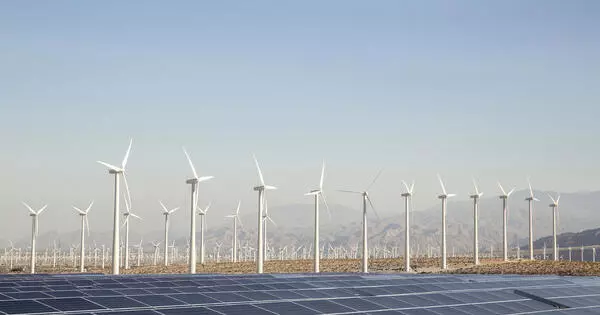Wind energy is a technologically mature energy source with enormous potential. It takes up less land because it extends vertically, requires minimal maintenance, and integrates perfectly with the circular economy model, making it increasingly competitive.
According to a new study, the health benefits of wind power could more than quadruple if operators reduced output from the most polluting fossil-fuel-based power plants when wind energy is available. However, disadvantaged communities would receive a smaller share of these benefits when compared to wealthier communities.
Nearly 10 percent of today’s electricity in the United States comes from wind power. The renewable energy source benefits climate, air quality, and public health by displacing emissions of greenhouse gases and air pollutants that would otherwise be produced by fossil-fuel-based power plants.
According to a new MIT study, the health benefits of wind power could more than quadruple if operators prioritized turning down output from the most polluting fossil-fuel-based power plants when wind energy is available.
Researchers examined the hourly activity of wind turbines as well as the reported emissions from every fossil-fuel-based power plant in the country between 2011 and 2017, according to the study published in Science Advances. They tracked emissions across the country and linked pollutants to affected demographic groups. They then calculated the regional air quality and associated health costs to each community.
We found that prioritizing health is a great way to maximize benefits in a widespread way across the U.S., which is a very positive thing. But it suggests it’s not going to address disparities.
Noelle Selin
The researchers discovered that wind power associated with state-level policies improved overall air quality in 2014, resulting in $2 billion in health benefits across the country. However, only about 30% of these health benefits reached underserved communities.
The team also discovered that reducing the output of the most polluting fossil-fuel-based power plants, rather than the most cost-effective plants, during times of wind-generated power could quadruple the overall health benefits to $8.4 billion nationwide. However, the demographic breakdown would be similar.
“We found that prioritizing health is a great way to maximize benefits in a widespread way across the U.S., which is a very positive thing. But it suggests it’s not going to address disparities,” says study co-author Noelle Selin, a professor in the Institute for Data, Systems and Society and the Department of Earth, Atmospheric and Planetary Sciences at MIT. “In order to address air pollution disparities, you can’t just focus on the electricity sector or renewables and count on the overall air pollution benefits addressing these real and persistent racial and ethnic disparities. You’ll need to look at other air pollution sources, as well as the underlying systemic factors that determine where plants are sited and where people live.”
Selin’s co-authors are lead author and former MIT graduate student Minghao Qiu PhD ’21, now at Stanford University, and Corwin Zigler at the University of Texas at Austin.

Turn-down service
In their new study, the team looked for patterns between periods of wind power generation and the activity of fossil-fuel-based power plants, to see how regional electricity markets adjusted the output of power plants in response to influxes of renewable energy.
“One of the technical challenges and contributions of this work is identifying which power plants respond to this increasing wind power,” Qiu says.
The researchers compared two historical datasets from 2011 to 2017: an hour-by-hour record of energy output from wind turbines across the country and a detailed record of emissions measurements from every fossil-fuel-based power plant in the United States. The datasets covered each of the seven major regional electricity markets, each of which supplied energy to one or more states.
“California and New York are each their own market, whereas the New England market covers around seven states, and the Midwest covers more,” Qiu explains. “We also cover about 95 percent of all the wind power in the U.S.”
In general, they observed that, in times when wind power was available, markets adjusted by essentially scaling back the power output of natural gas and sub-bituminous coal-fired power plants. They noted that the plants that were turned down were likely chosen for cost-saving reasons, as certain plants were less costly to turn down than others.
The researchers then used a sophisticated atmospheric chemistry model to simulate wind patterns and the chemical transport of emissions across the country, determining where and at what concentrations the emissions produced fine particulates and ozone – two pollutants known to harm air quality and human health. Finally, the researchers used U.S. census data to map general demographic populations across the country and used a standard epidemiological approach to calculate a population’s health cost as a result of pollution exposure.
This analysis revealed that, in the year 2014, a general cost-saving approach to displacing fossil-fuel-based energy in times of wind energy resulted in $2 billion in health benefits, or savings, across the country. disadvantaged populations, such as minority and low-income communities, received a smaller share of these benefits, though this disparity varied by state.
“It’s a more complicated story than we anticipated,” Qiu says. “Low-income people and racial minority groups are especially vulnerable to air pollution. We believe that developing wind power could narrow the gap in some states while widening it in others, depending on which fossil-fuel plants are displaced.”
Tweaking power
The researchers then examined how the pattern of emissions and the associated health benefits would change if they prioritized turning down different fossil-fuel-based plants in times of wind-generated power. They tweaked the emissions data to reflect several alternative scenarios: one in which the most health-damaging, polluting power plants are turned down first; and two other scenarios in which plants producing the most sulfur dioxide and carbon dioxide respectively, are first to reduce their output.
They discovered that, while each scenario increased overall health benefits, with the first scenario in particular having the potential to quadruple health benefits, the original disparity remained: minorities and low-income communities continued to experience lower health benefits than more affluent communities.
“We came to the conclusion that there was no way we could address this disparity by being smarter about which plants to displace,” Selin says. a little more than a few years ago. “Our role is to determine the most effective strategies for dealing with those challenges.”















